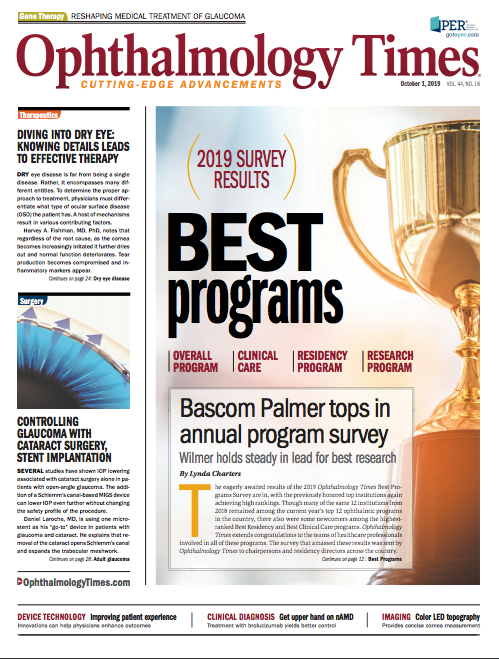Publication
Article
Digital Edition
Bascom Palmer tops in annual program survey
Author(s):
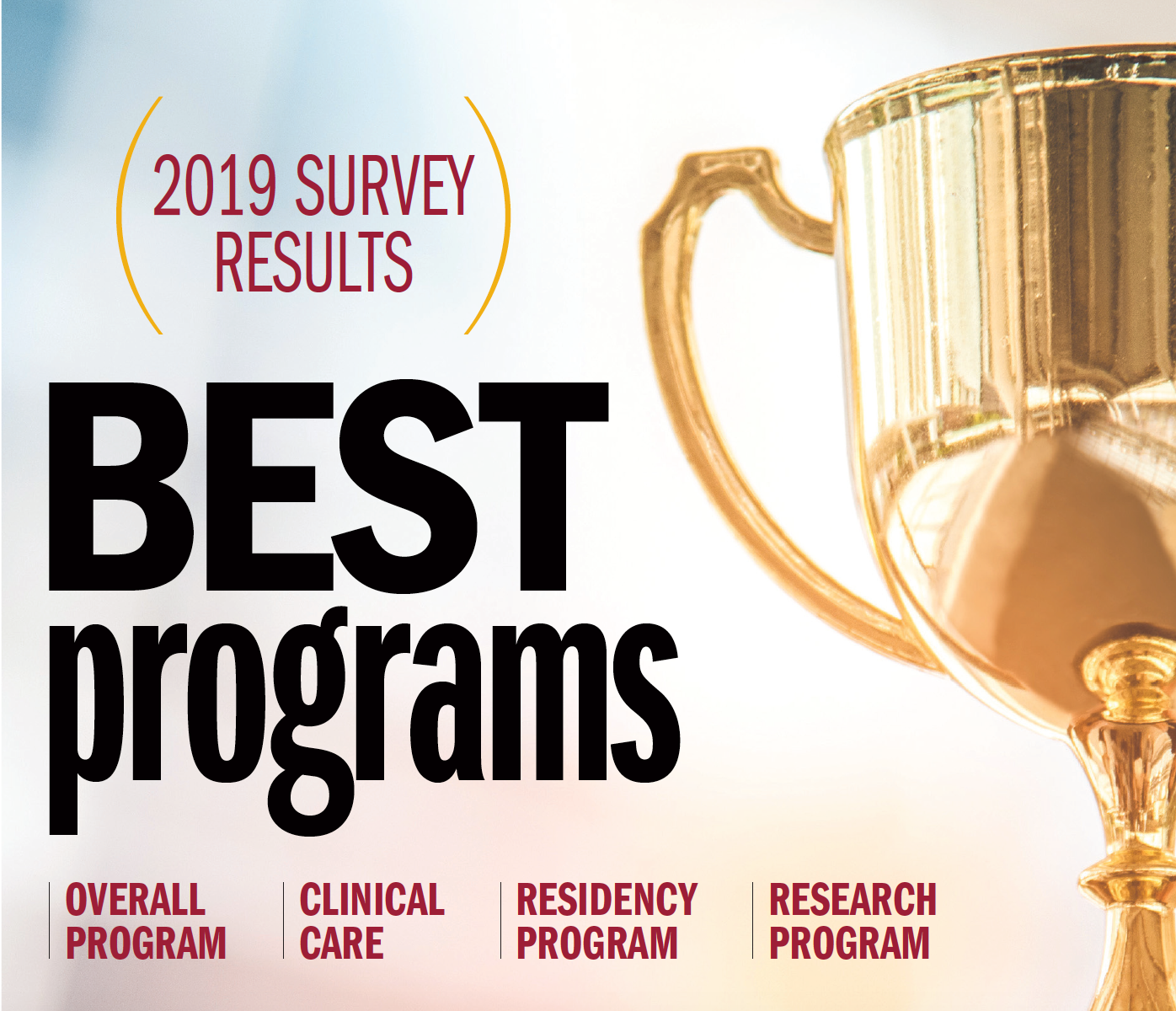
The eagerly awaited results of the 2019 Ophthalmology Times Best Programs Survey are in, with the previously honored top institutions again achieving high rankings.
Though many of the same 12 institutions from 2018 remained among the current year’s top 12 ophthalmic programs in the country, there also were some newcomers among the highest-ranked Best Residency and Best Clinical Care programs.
Ophthalmology Times extends congratulations to the teams of healthcare professionals involved in all of these programs. The survey that amassed these results was sent by Ophthalmology Times to chairpersons and residency directors across the country.
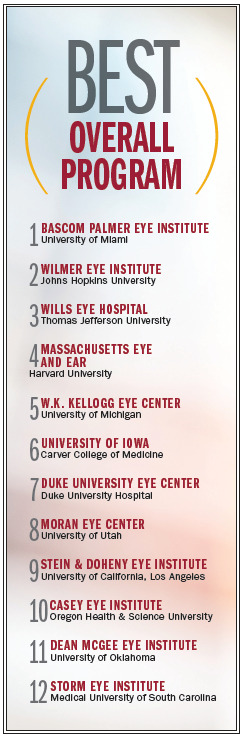
Best Overall Program
The two top leaders from last year, Bascom Palmer Eye Institute at the University of Miami and the Wilmer Eye Institute at Johns Hopkins University, again snared the Number 1 and 2 spots, respectively, in the Best Overall Program category. This year, Wills Eye Hospital at Thomas Jefferson University, captured the Number 3 position and in so doing nudged Massachusetts Eye and Ear, Harvard University, into the Number 4 spot.
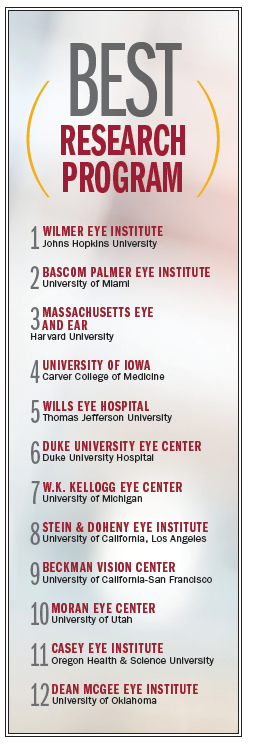
The other programs in the top 12 of Best Overall Program category are the W.K. Kellogg Eye Center, University of Michigan, in 5th place; University of Iowa, Carver College of Medicine, 6th place; Duke University Eye Center, Duke University Hospital, 7th place; Moran Eye Center, University of Utah, 8th place; Stein & Doheny Eye Institute, University of California, Los Angeles, 9th place; Casey Eye Institute, Oregon Health & Science University, 10th place; Dean McGee Eye Institute, University of Oklahoma, 11th place; and Storm Eye Institute, Medical University of South Carolina, 12th place.
All of these programs were the repeated their appearances in the 2018 Best Program Survey.
The W.K. Kellogg Eye Center and Moran Eye Center both advanced two places higher than last year’s rankings.
Three-fold mission
“Bascom Palmer is honored to receive these significant honors and rankings from Ophthalmology Times,” said Eduardo C. Alfonso, MD, director of the Bascom Palmer Eye Institute, and chairman, Department of Ophthalmology of the University of Miami Miller School of Medicine.
“In our mission to restore, preserve, and protect vision, our stellar team of ophthalmologists, vision researchers, ophthalmic technicians, nurses, and support staff are dedicated to providing superior eye care to each of our patients,” he added. “Everyone at Bascom Palmer is guided by the mission of our founder, Edward W. D. Norton, MD, who said: ‘The patient’s needs always come first.’”
Best Research Program
The top three research programs from last year, Wilmer Eye Institute, Bascom Palmer Eye Institute, and Massachusetts Eye and Ear, held onto their rankings. Most of the rest of last year’s programs maintained their high status. The University of Iowa rose from the 8th to 4th position, and both the Moran Eye Center and Stein & Doheny Eye Institute advanced two places.
A new program that entered this year’s list of the top 12 is the Dean McGee Eye Institute at the University of Oklahoma.
Pursuit of excellence
Peter J. McDonnell, MD, director and William Holland Wilmer Professor of Ophthalmology at the Wilmer Eye Institute expressed his congratulations to all the other excellent institutions recognized in this survey.
The pursuit of excellence is the hallmark of the Wilmer Eye research program.
“Our founder, Dr. Wilmer, established the Wilmer Eye Institute in 1925 with the belief that research, teaching, and patient care were so intimately intertwined that the pursuit of excellence in one area required the pursuit of excellence in all three areas,” Dr. McDonnell said.
“Consequently, we have always placed an emphasis on research regardless of whether it is conducted in the laboratory, in the clinic, or during the course of an epidemiologic study out in the ‘real world.’ The goal is to determine how we can better care for our patients,” he added. “Our residents and students participate in that research work, and we believe this is a key component of their educational experience.”
He went on to explain that Wilmer’s research has gone on to bear fruit.
“The largest licensing fees in the history of Johns Hopkins have come from ophthalmic surgical instruments developed at Wilmer,” Dr. McDonnell said. “In addition to partnerships with established pharmaceutical and device companies to bring our discoveries into the clinic, the Wilmer faculty teams have recently founded or co-founded 12 start-up companies for the purpose of translating exciting laboratory discoveries into new therapies that, if successful, will change how we care for patients.”
One example of these discoveries is a therapy for choroidal neovascularization in patients with age-related macular degeneration that would replace the currently used injection regimens that are extremely burdensome for both patients and physicians. Patients now receive injection every 1 to 2 months.
The new therapy would require patients to return for injections once or twice a year. This therapy is currently undergoing testing in clinical trials.
Dr. McDonnell also mentioned that the Wilmer biomedical engineering research program has undergone substantial growth.
Comprehensive team approach
Vittorio Porciatti, DSc, professor, director and vice chair of research at Bascom Palmer’s Evelyn F. and William L. McKnight Vision Research Center, commented on the institute’s Number 2 ranking in the Best Research category.
“What makes Bascom Palmer unique in research is the appropriate mixture of clinicians, clinician-scientists, and basic scientists that foster cross-fertilization and allow the addressing of the full temporal spectrum of all eye diseases, that is, preclinical, translational between preclinical and clinical (the so-called tipping point), and manifest,” Dr. Porciatti said.
“These different stages need to be addressed with different strategies, which require different fields of expertise to achieve the goals of prevention of visual loss, protection of existing vision, and restoration of lost vision,” he said. “Advanced technology leads the diverse fields and allows engineering of unique instrumentation and biomaterials that combine complementary disciplines and open new areas of investigation.”
Best Residency Program
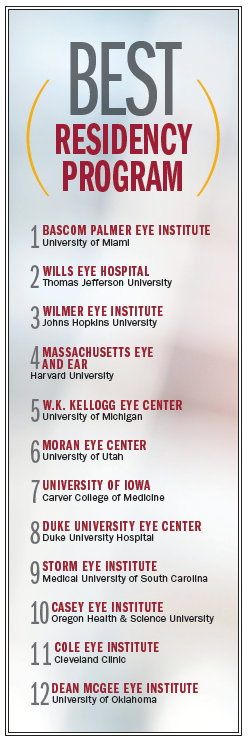
The standings in the Best Residency segment of the survey saw the three leaders, Bascom Palmer Eye Institute, Wills Eye Hospital, and Wilmer Eye Hospital, maintain their respective rankings from the previous year.
The Moran Eye Center achieved a ranking that is six places higher than in 2018, from 12th to 6th place, and Massachusetts Eye and Ear moved up from 7th place in 2018 to 4th place in the current rankings.
A newcomer to the top 12 programs this year is the Cole Eye Institute of the Cleveland Clinic that currently fills the 11th spot.
Positive impact on ophthalmology
Steven J. Gedde, MD, professor of ophthalmology, vice chair of education, and residency program director at Bascom Palmer, noted, that since the Institute’s inception in 1962, Bascom Palmer has been committed to training the next generation of leaders in ophthalmology.
“Each year, more than 500 well-qualified applicants apply for seven residency positions,” Dr. Gedde said. “That allows the institute to bring the best and the brightest into its residency training program. Additionally, 35 fellows train each year at the institute.
“The Bascom Palmer Eye Institute has made a tremendous positive impact on the field of ophthalmology through its training programs,” he added. “We have a depth of faculty in each subspecialty area, clinicians who are leaders in their field of expertise and superb teachers.”
Bascom Palmer creates an environment of learning that allows its physicians-in-training to realize their full potential. Upon completion of our training programs, all of its resident and fellow graduates provide outstanding patient care in their local communities, and many have joined academic institutions and are teaching others. This results in an exponential dissemination of knowledge and excellence in eye care, he added.
More than 45 graduates of Bascom Palmer’s training programs have become ophthalmology department chairpersons at medical schools and teaching hospitals throughout the world, which speaks to the success of the program, he added.
“Bascom Palmer has solidified its commitment to ophthalmic education and training with the creation of its Global Center for Ophthalmic Education,” Dr. Gedde said. “The Center organizes international partnerships, collaborates with ophthalmic societies and institutions around the world and produces professional lectures and educations events in South Florida, all of which have the common theme of advancing ophthalmic knowledge globally.”
Another component of Bascom Palmer’s graduate training is an innovative Master of Science in Vision Science and Investigative Ophthalmology (MVSIO) program, which is the first of its kind in the world.
MVSIO offers comprehensive training in translational research, problem-based learning, management, and a skill set available only at Bascom Palmer as it prepares students for a PhD program in vision science and investigative ophthalmology, Dr. Gedde explained.
Dedication to training
Fasika Woreta, MD, MPH, who is the director of the residency program at Wilmer Eye Institute and assistant professor of ophthalmology, commented on the

makings of a great residency program.
“I believe what makes us a top residency program is the number of world-renowned faculty who are dedicated to resident education,” Dr. Woreta said. “We have 51 faculty members who are integrally involved in teaching our 15 residents, with 22 faculty members who dedicate time and support to this endeavor. In addition, our residency attracts the top medical students in the country who are amazingly talented and go on to be top leaders in our field.”
Best Clinical Care Program
Bascom Palmer Eye Institute and Wills Eye Hospital held on to the Number 1 and 2 positions from last year’s survey. Wilmer Eye Institute overtook the 3rd spot from Massachusetts Eye and Ear, which earned the 4th slot.
A number of programs advanced substantially in this years’ rankings. W.K. Kellogg Eye Center moved up four spots from Number 9 to Number 5. Both the Stein & Doheny Eye Institute and Moran Eye Center moved up two positions into the 6th and 9th spots, respectively.
The Dean McGee Eye Institute and the U-W Department of Ophthalmology and Visual Sciences at the University of Wisconsin are new to the top 12 Clinical Care Programs this year and occupy the 11th and 12th places, respectively.
Treatment technologies
“Patients with glaucoma, macular diseases, diabetic retinopathy, and other sight-stealing conditions can look forward to advances in treatment, as Bascom Palmer’s clinicians and scientists team up to share their knowledge and expertise,” Dr. Alfonso said.
“Most recently, Bascom Palmer has successfully treated patients with gene therapy; developed new imaging techniques; produced the world’s first prosthetic 3-D eye, an innovative approach that could help millions of patients around the world who have undergone exenteration; and led national studies on the most effective surgical treatment for medically uncontrolled glaucoma,” he added. “The Artificial Intelligence and Computer Augmented Vision Laboratory has developed a novel artificial intelligence technology that augment patients’ visual loss from glaucoma, age-related macular degeneration, strokes, and retinitis pigmentosa using digital glasses.”
Bascom Palmer Eye Institute is scheduled this year to open the Lois Pope Center for Retinal & Macular Degeneration Research at its Palm Beach Gardens, FL, campus, which will be the most comprehensive retinal clinical research facility in the country.
Newsletter
Don’t miss out—get Ophthalmology Times updates on the latest clinical advancements and expert interviews, straight to your inbox.
